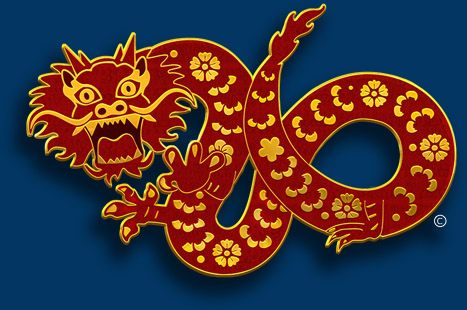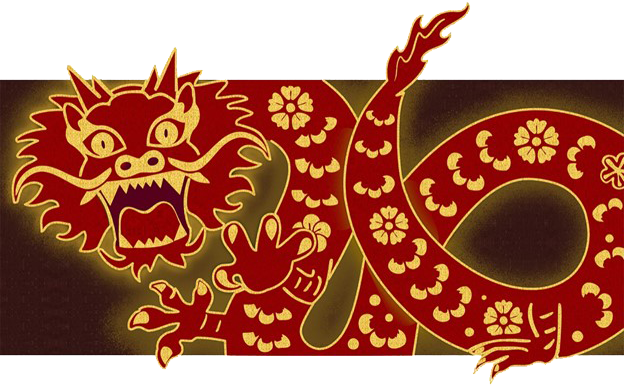Escaping The Wrist Grab
Part 2 – From The Opposite Side
by Christopher Caile

Editor's Note: This is the second article in a series on escaping from wrist grabs. Part 1 discussed several self-defense options against a same side grab. This article, will do the same for grabs of a wrist by the opponent's opposite arm. Part 3 will discuss two hand wrist grabs.
As discussed in Part 1of this series, while historically wrist grabs often related to stopping an opponent from use of a weapon, today they are most often used by one person to control another. Here the attacker has seized the defender's left wrist with his own right hand. As with Part 1, Part 2 will also discuss several self-defense options for this attack.
This article will explore and compare several self-defense techniques useful against a wrist grab from across the body. While there are also many other effective techniques, space limited what could be discussed. Those that are presented, however, are simple and effective.
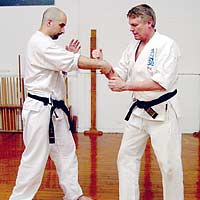 One method of self-defense against this technique is simply to raise your fist to the inside of the grab, as is shown here, and while grabbing your own fist with your other arm to pull back (this option is not shown) against the attacker's thumb — the weak link in most wrist grabs. This is similar to the first option presented in Part 1 against a grab from the same side. Often an initial strike to the face of the attacker with the opposite hand, or a quick, hard kick with the inside of the foot to the shin of the attacker will either make the assailant let go entirely or greatly distract him or her while you execute the second part of this technique.
One method of self-defense against this technique is simply to raise your fist to the inside of the grab, as is shown here, and while grabbing your own fist with your other arm to pull back (this option is not shown) against the attacker's thumb — the weak link in most wrist grabs. This is similar to the first option presented in Part 1 against a grab from the same side. Often an initial strike to the face of the attacker with the opposite hand, or a quick, hard kick with the inside of the foot to the shin of the attacker will either make the assailant let go entirely or greatly distract him or her while you execute the second part of this technique.
The advantage in this defense is that in pulling back you also pull the attacker's shoulder forward which can inhibit a punch by the other arm. Also, as you sink back you can move your weight to the back foot, allowing a front snap kick (not shown) by your front foot. From this position you can also easily run away.
There are a couple of disadvantages to this technique, however. First, you are using strength (and your weight) against the opponent's grip, and if he or she is significantly stronger, this escape might not work. Another problem is that while you are doing this, the attacker might be able to reach out and grab you or hit you with the other hand, or kick you. Thus this technique is problematic — good for some, but also dangerous.
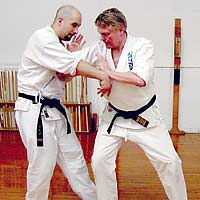 A second approach, which I prefer, is the following. Your free hand could strike out toward the opponent's face. This is optional, but it is a good distraction, or stunning technique, depending if you actually strike the opponent or not (this is not shown). Then, instead of pulling back against the grab — muscle against muscle — and supporting your wrist with your opposite palm (as seen in the photo), step in toward the attacker (be sure to raise your hand above the level of the attacker's grip on your wrist) while twisting to the side.
A second approach, which I prefer, is the following. Your free hand could strike out toward the opponent's face. This is optional, but it is a good distraction, or stunning technique, depending if you actually strike the opponent or not (this is not shown). Then, instead of pulling back against the grab — muscle against muscle — and supporting your wrist with your opposite palm (as seen in the photo), step in toward the attacker (be sure to raise your hand above the level of the attacker's grip on your wrist) while twisting to the side.
But there is more. If the attack is more than a playful interlude, this same movement can be turned into an attack. The first step is to use the bent elbow as a strike into the opponent's chest (shown here) or upwards into the face (not shown). If you step in deeply, the opponent will also be unbalanced to the rear.


This technique can also progress further. A natural extension is to continue the movement of your left hand into a palm-heel strike to the opponent's nose or face. The same hand can then grab the hair and pull the head forward into a back-hand strike (not shown), or alternatively grab the attacking arm (pulling back) as you simultaneously strike to the face with the other fist. If practiced, all three counter attacks (elbow, palm-heel and back-fist) flow in a continuous and powerful multiple counterattack that can be devastating. (1)
The advantage of this technique is that very little muscular strength is required. It is quick and powerful, and the defense turns into a simultaneous counter-attack. Since the attacker is off-balanced backward, this greatly reduces or eliminates any potential secondary attack from the attacker's opposite hand.
Here, the reader will also notice the similarity to the self-defense technique used against a same hand grab illustrated in Part I of this series. The technique shown here is another and alternate application of one of the beginning moves in the karate kata Saiha.
A totally different approach to this situation is to use a wrist lock, called a "nikyo" in aikido and some jujutsu systems, and by other names in other systems. In this technique you manipulate the arm and wrist into an "S" shape — an elbow bent at a 90 degree angle with the wrist bent back in the other direction.
Use your weight and not arm strength to pull the opponent forward at a 45 degree angle to the side. The extra benefit is that you have moved to the side out of range of an attack from the opposite arm. Here we have accentuated the movement to illustrate the point.
 A common mistake made by many teachers is to think that as a defender, it is easy to attain this position. It is not. A person who has grabbed you is tensed and intent on controlling you. Therefore the first move, if this technique is to be successful, is to distract the attacker (here with an open hand strike or slap to the face) while also leading him or her slightly off-balance.
A common mistake made by many teachers is to think that as a defender, it is easy to attain this position. It is not. A person who has grabbed you is tensed and intent on controlling you. Therefore the first move, if this technique is to be successful, is to distract the attacker (here with an open hand strike or slap to the face) while also leading him or her slightly off-balance.
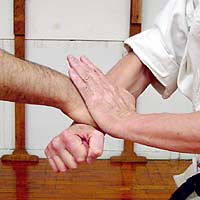 With the opponent's mind now reeling from the facial slap or strike, and additionally off-balanced, little attention remains focused on his grabbing arm. The attacker may just release his grab and in this case you have escaped. But, if the person continues to hold on, you can easily maneuver his arm into the "S" position. To secure the grabbing hand (if it hasn't already been released), use the palm of your opposite hand to hold the attacker's hand in position and then move your body toward the attacker. Your weight will begin to bend his arm inward.
With the opponent's mind now reeling from the facial slap or strike, and additionally off-balanced, little attention remains focused on his grabbing arm. The attacker may just release his grab and in this case you have escaped. But, if the person continues to hold on, you can easily maneuver his arm into the "S" position. To secure the grabbing hand (if it hasn't already been released), use the palm of your opposite hand to hold the attacker's hand in position and then move your body toward the attacker. Your weight will begin to bend his arm inward.


In the first photo the defender has opened his fist and circled his open hand, inside and up over the opponent's wrist. In many jujutsu, daito-ryu, aikido and other self-defense systems, the hand is left open. Here, however, the hand is laid down over the wrist. It is what happens next that is important, however (although some would maintain that the hand position shown allows this move to be executed more easily).
To make this technique now requires almost no force. You don't push down, a common mistake, or otherwise try to force the technique. Instead, rotate your hand in a circle back towards yourself (here using the index finger of the flat hand to rotate back towards your own center). The movement that rotates the opponent's wrist in one direction as the bent hand is held in place is very painful and instantaneous.
When you execute this technique be careful to keep your wrists close to your own center. While the technique also works if you extend your wrist outward toward the opponent's center (as some systems teach it), there is danger: the opponent, if you are not careful, can take over the same technique (since his hands are in virtually the same position as yours) and work the technique back on you. But if you hold your hands close to your own center, this will not happen.

This technique has the benefit of taking control of the opponent while also maximizing your position to minimize any potential counter. It has the disadvantage, however, of needing to execute the technique properly with the initial distraction, movement and off-balance.
In some karate kata you will see an open hand kaki (hooking) technique from the inside to the outside across the body. This move is accompanied by the opposite hand coming to rest on the hooking hand's wrist or forearm. In some kata this can be interpreted as the above described technique.
There is a famous story told in our Wadokai Aikido organization about a new aikido student who executed this technique with seemingly great proficiency.
As a new graduate student (at a southern U.S. urban university), her hours at school were long and she often studied until late. One night at about 11 PM she left the library to get a snack at a nearby convenience store just off campus.
She wasn't paying attention, just day dreaming and thinking to herself. As she left the store with a soft drink and a snack, she was suddenly grabbed by the right wrist (the attacker using his left hand). When she looked up she saw a large scruffy young man surrounded by a group of compatriots.
"Hi honey, where are you going," said the assailant, as he pulled her toward him. The others laughed.
She later reported, "I did that technique we practiced last week" — where she used her left hand to strike the opponent's face (distraction) as she pulled back and to the side (off balance). Then she put her left hand on top of the assailant's hand that was gripping her right wrist, and circled her own right hand over on top of his wrist, pulling it in while rotating her same right wrist (and the attacker's) towards herself — another "nikyo" technique — one of the most painful and powerful in the aikido repertoire.
"Ouch, ouch, hey, hey, hey" was the reply as the assailant dropped to his knees. His friends were so shocked they backed off. And no one wanted any more of her. She slipped back to the library a little wiser and more alert with a newly found respect for the aikido technique she had recently learned.
Footnote:
(1) You will notice here that you are driving your body forward into the backfist rather than sinking backward as was illustrated in Part I of this series of articles. In the above photo, the body is driven into the backfist while your other arm grabs the opponent's arm, which drives the attacker's head backward and his body off-balance to the rear. A typical follow-up technique is an arm bar, groin strike or leg take down. In Part I, however, the defender's body was sunk backwards. This allows you to use your body weight to pull either the opponent's arm back with you (as shown in Part I) or his head (not shown). With the opponent's head not driven backwards as far, the head remains within range for a variety of follow-up techniques. In saiha kata, for example (which supposes a grab of the head pulling it into a backfist), follow-up techniques include an elbow strike (same arm as the backfist) and/or a knee kick to the opponent's head as you pull it downward (and move him off balance to the side) followed up by a groin kick or stomp to the inside of the upper thigh driving it outward.

About the Author Christopher Caile

Screenshot
Christopher Caile is the Founder and Editor-In-Chief of FightingArts.com. He has been a student of the martial arts for over 65 years.
He first started in judo while in college. Then he added karate as a student of Phil Koeppel in 1959 studying Kempo and Wado-Ryu karate. He later added Shotokan Karate where he was promoted to brown belt and taught beginner classes. In 1960 while living in Finland, Caile introduced karate to that country and placed fourth in that nation's first national judo tournament.
Wanting to further his karate studies, Caile then hitch hiked from Finland to Japan traveling through Scandinavia, Europe, North Africa, the Middle East and South and Southeast Asia — living on 25 cents a day and often sleeping outside.
Arriving in Japan (1962), Caile was introduced to Mas Oyama and his fledgling full contact Kyokushinkai Karate by Donn Draeger, the famous martial artist and historian. Donn also housed him with several other senior international judo practitioners. Donn became Caile's martial arts mentor, coaching him in judo and introducing him to Shinto Muso-ryu under Takaji Shimizu.
Caile studied at Oyama's honbu dojo and also at Kenji Kurosaki's second Tokyo Kyokushinkai dojo. In his first day in class Oyama asked Caile to teach English to his chief instructor, Tadashi Nakamura. They have been friends ever since. Caile also participated in Oyama's masterwork book, "This Is Karate."
Caile left Japan with his black belt and designation as Branch Chief, the first in the US to have had extensive training in Japan directly under Oyama Sensei. As such, Oyama Sensei asked him to be his representative on visits to his US dojos to report on their status.
A little over a year later, Nakamura, Kusosaki and Akio Fujihira won an epic David vs. Goliath challenge match against Thailand's professional Muay Thai Boxers in Bangkok, Thailand, thrusting Kyolushinkai and Nakamura into national prominence.
Back in the US Caile taught Kyokushinkai karate in Peoria, Il while in college and later in Washington, DC. while in graduate school. Durimg this time Shihan Nakamura had moved to New York City to head Kyokushinkai's North American Operation.
In 1976 when Kaicho Tadashi Nakamura formed the World Seido Karate organization, Caile followed. Living then in Buffalo, NY, Caile taught Seido karate and self-defense at the State University of New York at Buffalo (SUNY Buffalo) for over 15 years where he also frequently lectured on martial arts and Zen in courses on Japanese culture.
Caile moved to New York City in 1999 to marry Jackie Veit. He is now an 8th degree black belt, Hanshi, training in Seido Karate's Westchester, NY Johshin Honzan (Spiritual Center) dojo. In Seido Caile is known for his teaching of and seminars on kata applications. He also produced a 14 segment video series on Pinan kata Bunkai currently available to Seido members.
Caile is also a long-time student and Shihan in Aikido. He studied in Buffalo, under Mike Hawley Shihan, and then under Wadokai Aikido's founder, the late Roy Suenaka (uchi deshi under Morihei Ueshiba, founder of Aikido and was Shihan under Tohei Sensei). In karate, Suenaka (8thdan) was also an in-house student of the Okinawan karate master Hohan Soken.
Having moved to New York City, Caile in 2000 founded this martial arts educational website, FightingArts.com. Twenty-five years later, in 2025, it underwent a major update and revision.
For FightingArts.com and other publications Caile wrote hundreds of articles on karate, martial arts, Japanese art, Chinese Medicine and edited a book on Zen. He also developed relationships with a cross section of leading martial arts teachers. Over the last four decades he has conducted extensive private research into karate and martial arts including private translations of the once secret Okinawan hand copied and passed on Kung Fu book, the Bubishi, as well as an early karate book by the karate master Kenwa Mabuni. He periodically returns to Japan and Okinawa to continue his studies and participate Seido karate events. In Tokyo he practiced (with Roy Suenaka Sensei) in a variety of aikido organizations with their founders – including private interviews and practices at the Aiki-kai Aikido Honbu dojo with the son and grandson of aikido's founder, Doshu (headmaster) Kisshomaru (an old uchi-deshi friend) and his son, Moriteru Ueshiba and in Iwama with Morihiro Saito. On Okinawa he studied Goju Ryu karate under Eiichi Miyazato, 10th dan founder of Naha's Jundokan, and also with Yoshitaka Taira (who later formed his own organization, who specialized in kata Bunkai. While there Caile also trained with Hohan Soken's senior student, Master Fusei Kise, 10 dan as well as with the grandson of the legendary karate master Anko Itosu.
Caile's other martial arts experience includes: Diato-ryu Aikijujitsu and Kenjitsu, kobudo, boxing, Muay Thai, MMA, Kali (empty hand, knife and bolo), study of old Okinawan Shoran-ryu & Tomari body mechanics, study of old Okinawan kata under Richard Kim, study of close quarter defense and combat, including knife and gun defenses, Kyusho Jitsu and several Chinese fighting arts including 8 Star Praying Mantis, Pak Mei (White Eyebrow), and a private family system of Kung Fu.
Caile is also a student of Zen as well as a long-term student of one branch of Traditional Chinese Medicine, Chi Kung (Qigong). As one of two senior disciples of Chi Kung master Dr. Shen (M.D., Ph.D.) Caile was certified to teach and practice. This led to Caile's founding of the The Chi Kung Healing Institute on Grand Island, NY. In Western NY, he also frequently held Chi Kung seminars, including at SUNY Buffalo and at the famous Chautauqua Institution in Chautauqua, NY. His articles on Chi Kung also appeared in the Holistic Health Journal and in several books on alternative medicine.
Caile holds a BA in International Studies from Bradley University and MA in International Relations with a specialty in South and Southeast Asia from American University in Washington, D.C. While in Buffalo, NY he also studied digital and analog electronics.
In his professional life Caile also worked in public relations and as a newspaper reporter and photographer. Earlier he worked in the field of telecommunications including Managing a Buffalo, NY sales and service branch for ITT. He then founded his own private telephone company. This was followed by creation of an electrical engineering company that designed and patented his concept for a new type of low-cost small business telephone system (which was eventually sold to Bell South). The company also did contract work for Kodak and the US space program. Simultaneously Caile designed and manufactured a unique break-apart portable pontoon boat.
Most recently Caile co-founded an internet software company. Its products include software suites with AI capability for control and management of streaming media, such as video and music, an all-in-one book publishing software product for hardcover, eBook and audio book creation and security software for buildings and government use.
For more details about Christopher Caile's martial arts, work experience and life profile, see the About section in the footer of this site.
Search for more articles by this author:


